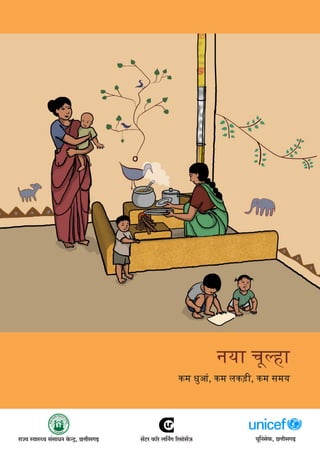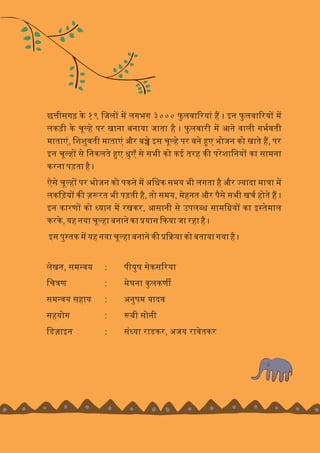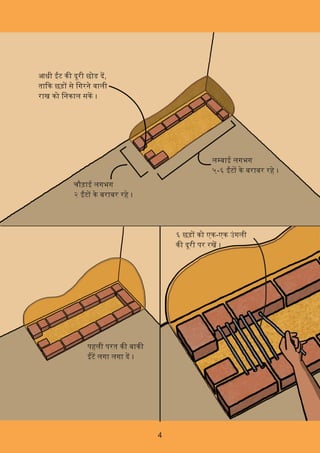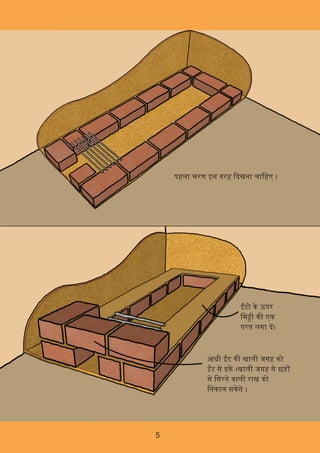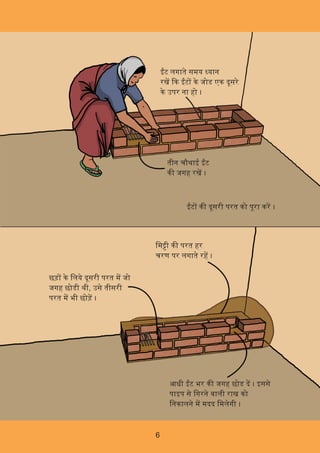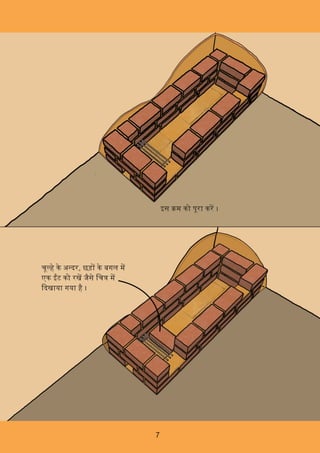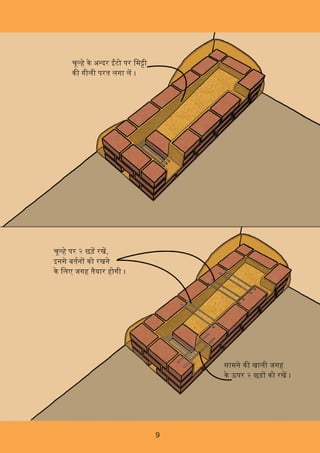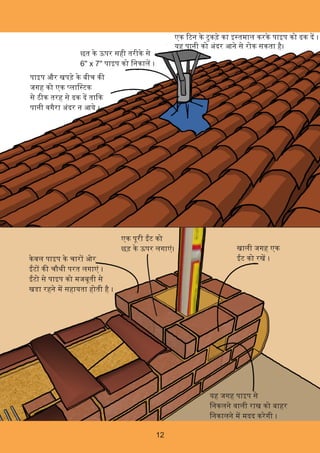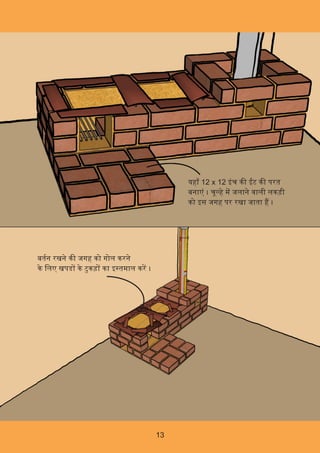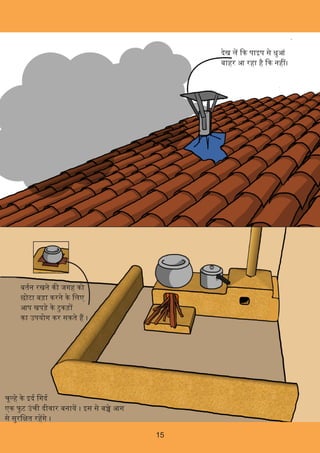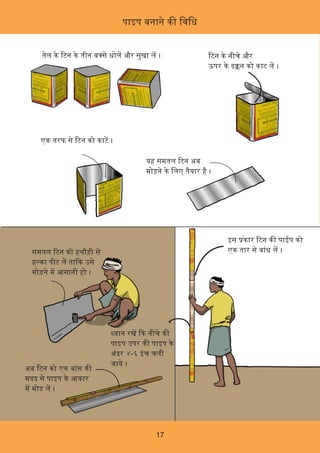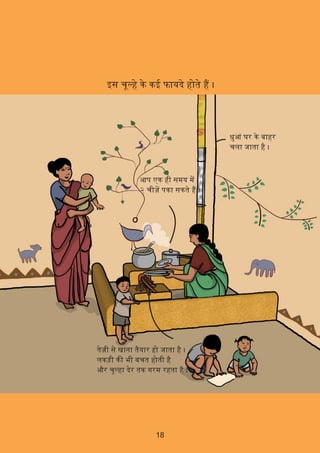Smokeless chulha construction manual
- 1. g|Q>a $m┬░a b{Z┬¬J [agmog}┬ĄO Óż©Óż»ÓżŠ ÓżÜÓźé Óż╣ÓżŠ ÓżĢÓż« Óż¦ÓźüÓżåÓżé, ÓżĢÓż« Óż▓ÓżĢÓź£ÓźĆ, ÓżĢÓż« ÓżĖÓż«Óż» `y{Zgo$, N>├ÄmrgJŌĆ╣T>am├ü` ├▒dm├▒├Å` g┬¦gmYZ Ho$├Ø├É, N>├ÄmrgJŌĆ╣T>
- 2. Óżø ÓźĆÓżĖÓżŚÓźØ ÓżĢÓźć Óź¦Óź» Óż┐Óż£Óż▓ Óż« Óż▓ÓżŚÓżŁÓżŚ Óź®Óź”Óź”Óź” Óż½Óźü Óż▓ÓżĄÓżŠ Óż░Óż»ÓżŠÓżé Óż╣ Óźż ÓżćÓż© Óż½Óźü Óż▓ÓżĄÓżŠ Óż░Óż» Óż« Óż▓ÓżĢÓź£ÓźĆ ÓżĢÓźć ÓżÜÓźé Óż╣Óźć Óż¬Óż░ Óż¢ÓżŠÓż©ÓżŠ Óż¼Óż©ÓżŠÓż»ÓżŠ Óż£ÓżŠÓżżÓżŠ Óż╣Óźł Óźż Óż½Óźü Óż▓ÓżĄÓżŠÓż░ÓźĆ Óż« ÓżåÓż©Óźć ÓżĄÓżŠÓż▓ÓźĆ ÓżŚÓżŁÓżĄÓżżÓźĆ Óż«ÓżŠÓżżÓżŠÓżÅÓżé, Óż┐ÓżČÓżČÓźüÓżĄÓżżÓźĆ Óż«ÓżŠÓżżÓżŠÓżÅÓżé ÓżöÓż░ Óż¼ Óźć ÓżćÓżĖ ÓżÜÓźé Óż╣Óźć Óż¬Óż░ Óż¼Óż©Óźć ÓżÅ ÓżŁÓźŗÓż£Óż© ÓżĢÓźŗ Óż¢ÓżŠÓżżÓźć Óż╣, Óż¬Óż░ ÓżćÓż© ÓżÜÓźé Óż╣ ÓżĖÓźć Óż┐Óż©ÓżĢÓż▓ÓżżÓźć ÓżÅ Óż¦ÓźüÓżÅÓżü ÓżĖÓźć ÓżĖÓżŁÓźĆ ÓżĢÓźŗ ÓżĢÓżł ÓżżÓż░Óż╣ ÓżĢ Óż¬Óż░ÓźćÓżČÓżŠÓż┐Óż©Óż» ÓżĢÓżŠ ÓżĖÓżŠÓż«Óż©ÓżŠ ÓżĢÓż░Óż©ÓżŠ Óż¬Óź£ÓżżÓżŠ Óż╣Óźł Óźż ÓżÉÓżĖÓźć ÓżÜÓźé Óż╣ Óż¬Óż░ ÓżŁÓźŗÓż£Óż© ÓżĢÓźŗ Óż¬ÓżĢÓż©Óźć Óż« ÓżģÓż┐Óż¦ÓżĢ ÓżĖÓż«Óż» ÓżŁÓźĆ Óż▓ÓżŚÓżżÓżŠ Óż╣Óźł ÓżöÓż░ Óż»ÓżŠÓż”ÓżŠ Óż«ÓżŠ ÓżŠ Óż« Óż▓ÓżĢÓż┐Óź£Óż» ÓżĢ Óźø Óż░Óżż ÓżŁÓźĆ Óż¬Óź£ÓżżÓźĆ Óż╣,Óźł ÓżżÓźŗ ÓżĖÓż«Óż», Óż«ÓźćÓż╣Óż©Óżż ÓżöÓż░ Óż¬ÓźłÓżĖÓźć ÓżĖÓżŁÓźĆ Óż¢ÓżÜ Óż╣ÓźŗÓżżÓźć Óż╣ Óźż ÓżćÓż© ÓżĢÓżŠÓż░ÓżŻ ÓżĢÓźŗ Óż»ÓżŠÓż© Óż« Óż░Óż¢ÓżĢÓż░, ÓżåÓżĖÓżŠÓż©ÓźĆ ÓżĖÓźć ÓżēÓż¬Óż▓ Óż¦ ÓżĖÓżŠÓż«Óż┐ Óż» ÓżĢÓżŠ Óżć ÓżżÓż«Óźć ÓżŠÓż▓ ÓżĢÓż░ÓżĢÓźć, Óż»Óż╣ Óż©Óż»ÓżŠ ÓżÜÓźé Óż╣ÓżŠ Óż¼Óż©ÓżŠÓż©Óźć ÓżĢÓżŠ Óż»ÓżŠÓżĖ ÓżĢÓż»ÓżŠ Óż£ÓżŠ Óż░Óż╣ÓżŠ Óż╣Óźł Óźż ÓżćÓżĖ Óż¬Óźü ÓżżÓżĢ Óż« Óż»Óż╣ Óż©Óż»ÓżŠ ÓżÜÓźé Óż╣ÓżŠ Óż¼Óż©ÓżŠÓż©Óźć ÓżĢ Óż»ÓżŠ ÓżĢÓźŗ Óż¼ÓżżÓżŠÓż»ÓżŠ ÓżŚÓż»ÓżŠ Óż╣Óźł Óźż Óż▓ÓźćÓż¢Óż©, ÓżĖÓż« ÓżĄÓż» : Óż¬ÓźĆÓż»ÓźüÓżĘ ÓżĖÓźćÓżĢÓżĖ Óż░Óż»ÓżŠ Óż┐ÓżÜ ÓżŻ : Óż«ÓźćÓżśÓż©ÓżŠ ÓżĢÓźüÓż▓ÓżĢÓżŻ ÓżĖÓż« ÓżĄÓż» ÓżĖÓż╣ÓżŠÓż» : ÓżģÓż©ÓźüÓż¬Óż« Óż»ÓżŠÓż”ÓżĄ ÓżĖÓż╣Óż»ÓźŗÓżŚ : Óż¼ÓźĆ ÓżĖÓźŗÓż©ÓźĆ Óż┐ÓżĪÓźøÓżŠÓżćÓż© : ÓżĖÓżé Óż»ÓżŠ Óż░ÓżŠÓżĪÓżĢÓż░, ÓżģÓż£Óż» Óż░ÓżŠÓżĄÓźćÓżżÓżĢÓż░
- 3. 1 Óż╣Óż« ÓżÅÓżĢ ÓżøÓźŗÓż¤Óźć ÓżÜÓźé Óż╣Óźć Óż¬Óż░ Óż¢ÓżŠÓż©ÓżŠ Óż¼Óż©ÓżŠÓżżÓźć Óż╣ ÓżöÓż░ Óż¬ÓźéÓż░Óźć Óż¬ Óż░ÓżĄÓżŠÓż░ ÓżĢÓźŗ Óż┐Óż¢Óż▓ÓżŠÓżżÓźć Óż╣ Óźż ÓżÜÓźé Óż╣ÓżŠ Óż© ÓżĢÓźćÓżĄÓż▓ Óż¦ÓźüÓżéÓżå Óż½Óźł Óż▓ÓżŠÓżżÓżŠ Óż╣,Óźł Óż¼Óż┐ ÓżĢ Óż╣Óż«ÓżŠÓż░ÓźĆ ÓżöÓż░ Óż╣Óż«ÓżŠÓż░Óźć Óż¼ ÓżĢ ÓżåÓżüÓż¢ ÓżöÓż░ Óż½Óż½ÓżĪÓźŗ ÓżĢÓźŗ Óż©ÓźüÓżĢÓżĖÓżŠÓż© ÓżŁÓźĆ Óż¬ ÓżÜÓżé ÓżŠÓżżÓżŠ Óż╣Óźł Óźż Óż»Óż╣ Óż╣Óż«ÓżŠÓż░Óźć ÓżĄÓżŠ Óż» ÓżĢÓźŗ Óż╣ÓżŠÓż┐Óż© Óż¬ ÓżÜÓżé ÓżŠÓżżÓżŠ Óż╣Óźł Óźż ÓżåÓż£ Óż╣Óż« ÓżÅÓżĢ Óż¼ÓźćÓż╣ÓżżÓż░ Óż©Óż»ÓżŠ ÓżÜÓźé Óż╣ÓżŠ Óż¼Óż©ÓżŠÓż©Óźć ÓżĢ Óż»ÓżŠ ÓżĖÓźĆÓż¢ÓżŚÓźćÓźż Óż©ÓźĆÓżÜÓźć Óż”Óż¢ÓżŠÓżł ÓżĖÓżŠÓż« ÓźĆ Óż£ÓźüÓż¤ÓżŠ Óż▓ Óźż Óź¬-Óź½ ÓżżÓżŚÓżŠÓź£ÓźĆ Óż┐Óż« ÓźĆ Óż½ÓżŠÓżĄÓź£ÓżŠ Óż▓ÓżŚÓżŁÓżŚ Óź½Óź” ÓżćÓżéÓż¤ Óź© ÓżżÓżŚÓżŠÓź£ÓźĆ Óż¼ÓżŠÓż▓Óźé ÓżĢÓż© Óż▓ÓżŚÓżŁÓżŚ Óź©Óź” Óż▓ÓźŗÓż╣Óźć ÓżĢ ÓżøÓź£Óźć Óź¦Óź”-Óź¦Óź© ÓżćÓżéÓżÜ Óż▓ÓżéÓż¼ÓźĆ Óź¦Óź” Óż¢Óż¬Óź£Óźć ÓżĢÓźć Óż¤ÓźüÓżĢÓź£Óźć Óż¬ÓżŠÓż©ÓźĆ
- 4. 2 Óż┐Óż« ÓźĆ Óż┐Óż«Óż▓ÓżŠÓżÅÓżé Óźż ÓżÉÓżĖÓżŠ ÓżĢÓźŗÓż©ÓżŠ ÓżÜÓźüÓż©Óźć Óż£Óż╣ÓżŠÓżü Óż¬Óż░ ÓżÜÓźé Óż╣ÓżŠ Óż¼Óż©ÓżŠÓż©ÓżŠ Óż╣Óźł Óźż Óż£Óż«ÓźĆÓż© ÓżĢÓźŗ Óż╣ ÓżĢÓźć ÓżĖÓźć ÓżŚÓźĆÓż▓ÓżŠ ÓżĢÓż░ Óż▓ Óźż
- 5. 3 Óż¤ Óż┐Óż¼ÓżøÓżŠÓż©Óźć ÓżĖÓźć Óż¬Óż╣Óż▓Óźć Óż┐Óż«Óż¤Óż¤ÓźĆ ÓżĢ ÓżÅÓżĢ Óż¬Óż░Óżż Óż▓ÓżŚÓżŠÓż▓ Óźż Óż┐Óż¼ÓżøÓżŠÓż©Óźć ÓżĖÓźć Óż¬Óż╣Óż▓Óźć Óż¤ ÓżĢÓźŗ Óż¬ÓżŠÓż©ÓźĆ ÓżĖÓźć Óż┐ÓżŁÓżŚÓźŗÓż▓ Óźż Óż¤Óźŗ ÓżĢÓźŗ Óż”ÓźĆÓżĄÓżŠÓż░Óźŗ ÓżĖÓźć ÓżÅÓżĢ Óż╣ÓżŠÓżź ÓżĢ Óż”Óż░Óźé ÓźĆ Óż¬Óż░ Óż▓ÓżŚÓżŠÓż» Óźż Óż┐Óż£Óż© Óż¼ÓżżÓż© Óż« Óż¢ÓżŠÓż©ÓżŠ Óż¼Óż©ÓżŠÓżżÓźć Óż╣, ÓżēÓż©ÓżĢÓźŗ Óż░Óż¢ ÓżĢÓż░ ÓżÜÓźé Óż╣Óźć ÓżĢ Óż▓ Óż¼ÓżŠÓżł ÓżöÓż░ ÓżÜÓźīÓź£ÓżŠÓżł ÓżżÓż» ÓżĢÓż░ Óż▓Óźż
- 6. 44 ÓżåÓż¦ÓźĆ Óż¤ ÓżĢ Óż”Óż░Óźé ÓźĆ ÓżøÓźŗÓżĪ Óż”, ÓżżÓżŠ ÓżĢ ÓżøÓź£ ÓżĖÓźć Óż┐ÓżŚÓż░Óż©Óźć ÓżĄÓżŠÓż▓ÓźĆ Óż░ÓżŠÓż¢ ÓżĢÓźŗ Óż┐Óż©ÓżĢÓżŠÓż▓ ÓżĖÓżĢ Óźż ÓżÜÓźīÓź£ÓżŠÓżł Óż▓ÓżŚÓżŁÓżŚ Óź© Óż¤ ÓżĢÓźć Óż¼Óż░ÓżŠÓż¼Óż░ Óż░Óż╣Óźć Óźż Óż▓ Óż¼ÓżŠÓżł Óż▓ÓżŚÓżŁÓżŚ Óź½-Óź¼ Óż¤ ÓżĢÓźć Óż¼Óż░ÓżŠÓż¼Óż░ Óż░Óż╣Óźć Óźż Óź¼ ÓżøÓź£ ÓżĢÓźŗ ÓżÅÓżĢ-ÓżÅÓżĢ ÓżēÓżéÓżŚÓż▓ÓźĆ ÓżĢ Óż”Óż░Óźé ÓźĆ Óż¬Óż░ Óż░Óż¢ Óźż Óż¬Óż╣Óż▓ÓźĆ Óż¬Óż░Óżż ÓżĢ Óż¼ÓżŠÓżĢ Óż¤ Óż▓ÓżŚÓżŠ Óż▓ÓżŚÓżŠ Óż” Óźż
- 7. 5 Óż¬Óż╣Óż▓ÓżŠ ÓżÜÓż░ÓżŻ ÓżćÓżĖ ÓżżÓż░Óż╣ Óż”Óż¢Óż©ÓżŠ ÓżÜÓżŠÓż┐Óż╣ÓżÅ Óźż Óż¤Óźŗ ÓżĢÓźć ÓżŖÓż¬Óż░ Óż┐Óż« ÓźĆ ÓżĢ ÓżÅÓżĢ Óż¬Óż░Óżż Óż▓ÓżŚÓżŠ Óż”Óźż ÓżåÓż¦ÓźĆ Óż¤ ÓżĢ Óż¢ÓżŠÓż▓ÓźĆ Óż£ÓżŚÓż╣ ÓżĢÓźŗ Óż¤ ÓżĖÓźć ÓżóÓżĢ ÓźżÓż¢ÓżŠÓż▓ÓźĆ Óż£ÓżŚÓż╣ ÓżĖÓźć ÓżøÓź£ ÓżĖÓźć Óż┐ÓżŚÓż░Óż©Óźć ÓżĄÓżŠÓż▓ÓźĆ Óż░ÓżŠÓż¢ ÓżĢÓźŗ Óż┐Óż©ÓżĢÓżŠÓż▓ ÓżĖÓżĢÓżŚÓźć Óźż
- 8. 6 Óż¤ ÓżĢ Óż”ÓżĖÓźé Óż░ÓźĆ Óż¬Óż░Óżż ÓżĢÓźŗ Óż¬ÓźéÓż░ÓżŠ ÓżĢÓż░ Óźż ÓżżÓźĆÓż© ÓżÜÓźīÓżźÓżŠÓżł Óż¤ ÓżĢ Óż£ÓżŚÓż╣ Óż░Óż¢ Óźż ÓżøÓź£ ÓżĢÓźć Óż┐Óż▓Óż»Óźć Óż”ÓżĖÓźé Óż░ÓźĆ Óż¬Óż░Óżż Óż« Óż£Óźŗ Óż£ÓżŚÓż╣ ÓżøÓźŗÓżĪÓźĆ ÓżźÓźĆ, ÓżēÓżĖÓźć ÓżżÓźĆÓżĖÓż░ÓźĆ Óż¬Óż░Óżż Óż« ÓżŁÓźĆ ÓżøÓźŗÓź£ Óźż Óż┐Óż« ÓźĆ ÓżĢ Óż¬Óż░Óżż Óż╣Óż░ ÓżÜÓż░ÓżŻ Óż¬Óż░ Óż▓ÓżŚÓżŠÓżżÓźć Óż░Óż╣ Óźż ÓżåÓż¦ÓźĆ Óż¤ ÓżŁÓż░ ÓżĢ Óż£ÓżŚÓż╣ ÓżøÓźŗÓżĪ Óż” Óźż ÓżćÓżĖÓżĖÓźć Óż¬ÓżŠÓżćÓż¬ ÓżĖÓźć Óż┐ÓżŚÓż░Óż©Óźć ÓżĄÓżŠÓż▓ÓźĆ Óż░ÓżŠÓż¢ ÓżĢÓźŗ Óż┐Óż©ÓżĢÓżŠÓż▓Óż©Óźć Óż« Óż«Óż”Óż” Óż┐Óż«Óż▓ÓźćÓżŚÓźĆ Óźż Óż¤ Óż▓ÓżŚÓżŠÓżżÓźć ÓżĖÓż«Óż» Óż»ÓżŠÓż© Óż░Óż¢ ÓżĢ Óż¤ ÓżĢÓźć Óż£ÓźŗÓżĪ ÓżÅÓżĢ Óż”ÓżĖÓźé Óż░Óźć ÓżĢÓźć ÓżēÓż¬Óż░ Óż©ÓżŠ Óż╣Óźŗ Óźż
- 9. 7 ÓżćÓżĖ Óż« ÓżĢÓźŗ Óż¬ÓźéÓż░ÓżŠ ÓżĢÓż░ Óźż ÓżÜÓźé Óż╣Óźć ÓżĢÓźć Óżģ Óż”Óż░, ÓżøÓź£ ÓżĢÓźć Óż¼ÓżŚÓż▓ Óż« ÓżÅÓżĢ Óż¤ ÓżĢÓźŗ Óż░Óż¢ Óż£ÓźłÓżĖÓźć Óż┐ÓżÜ Óż« Óż”Óż¢ÓżŠÓż»ÓżŠ ÓżŚÓż»ÓżŠ Óż╣Óźł Óźż
- 10. 8 Óż¼ÓżŠÓż▓Óźé ÓżĢÓźć ÓżŖÓż¬Óż░ Óż┐Óż« ÓźĆ ÓżĢ ÓżŚÓźĆÓż▓ÓźĆ Óż¬Óż░Óżż Óż▓ÓżŚÓżŠÓżÅÓżé Óźż ÓżÜÓźé Óż╣Óźć ÓżĢÓźć ÓżģÓżéÓż”Óż░ Óż¼ÓżŠÓż▓Óźé ÓżŁÓż░ Óż”Óźż Óż½Óż░ ÓżćÓżĖ Óż¼ÓżŠÓż▓Óźé ÓżĢÓźŗ Óż½ÓżĖÓż▓ Óż¬ ÓźĆ ÓżĢ ÓżżÓż░Óż╣ ÓżĢ ÓźØÓż▓ÓżŠÓż© Óż”Óźć Óż”Óźż
- 11. 9 ÓżÜÓźé Óż╣Óźć Óż¬Óż░ Óź© ÓżøÓź£ Óż░Óż¢, ÓżćÓż©ÓżĖÓźć Óż¼ÓżżÓż© ÓżĢÓźŗ Óż░Óż¢Óż©Óźć ÓżĢÓźć Óż┐Óż▓ÓżÅ Óż£ÓżŚÓż╣ ÓżżÓźłÓż»ÓżŠÓż░ Óż╣ÓźŗÓżŚÓźĆ Óźż ÓżĖÓżŠÓż«Óż©Óźć ÓżĢ Óż¢ÓżŠÓż▓ÓźĆ Óż£ÓżŚÓż╣ ÓżĢÓźć ÓżŖÓż¬Óż░ Óź© ÓżøÓź£ ÓżĢÓźŗ Óż░Óż¢ Óźż ÓżÜÓźé Óż╣Óźć ÓżĢÓźć Óżģ Óż”Óż░ Óż¤Óźŗ Óż¬Óż░ Óż┐Óż« ÓźĆ ÓżĢ ÓżŚÓźĆÓż▓ÓźĆ Óż¬Óż░Óżż Óż▓ÓżŚÓżŠ Óż▓ Óźż
- 12. 10 Óż»Óż╣ÓżŠÓżü ÓżÅÓżĢ Óż¤ Óż░Óż¢Óż©Óźć ÓżĢÓźć Óż┐Óż▓ÓżÅ Óż”Óźŗ ÓżøÓź£ Óż░Óż¢ Óźż ÓżÜÓźé Óż╣Óźć ÓżĢÓźŗ Óż©ÓżŠÓż¬Óż©Óźć ÓżĢÓźć Óż┐Óż▓ÓżÅ Óż£Óźŗ Óż¼ÓżżÓż© ÓżĢÓżŠ Óżć ÓżżÓźćÓż«ÓżŠÓż▓ Óż¬Óż╣Óż▓Óźć ÓżĢÓż»ÓżŠ ÓżŚÓż»ÓżŠ ÓżźÓżŠ, Óżē Óż╣ ÓżĢÓżŠ ÓżēÓż¬Óż»ÓźŗÓżŚ ÓżĢÓż░ÓżĢÓźć ÓżøÓź£ ÓżĢ Óż£ÓżŚÓż╣ ÓżżÓż» ÓżĢÓż░ Óż▓Óźż ÓżøÓź£ ÓżĢÓźŗ ÓżóÓżĢÓż©Óźć ÓżĢÓźć Óż┐Óż▓ÓżÅ ÓżåÓż¦Óźć Óż¤ÓźéÓż¤Óźć ÓżÅ Óż¢Óż¬ÓżĪ ÓżĢÓżŠ ÓżēÓż¬Óż»ÓźŗÓżŚ ÓżĢÓż░ Óźż ÓżģÓżŚÓż░ Óż¤ÓźüÓżĢÓź£Óźć Óż¼Óź£Óźć Óż╣ ÓżżÓźŗ Óżē Óż╣ ÓżåÓż¦Óźć Óż┐Óż╣ ÓżĖ Óż« ÓżżÓźŗÓź£ Óż” Óźż
- 13. Óż¬ÓżŠÓżćÓż¬ ÓżĢ ÓżĖÓż╣ÓźĆ Óż£ÓżŚÓż╣ ÓżżÓż» ÓżĢÓż░Óż©Óźć ÓżĢÓźć Óż┐Óż▓ÓżÅ, ÓżøÓżż ÓżĖÓźć ÓżĢÓźüÓżø Óż¢Óż¬Óź£Óźć Óż╣Óż¤ÓżŠ ÓżĢÓż░ Óż¬ÓżŠÓżćÓż¬ ÓżĢÓźŗ Óż░Óż¢ÓżĢÓż░ Óż”Óż¢Óźć Óźż ÓżøÓź£ ÓżĢÓźć ÓżŖÓż¬Óż░ Óż¬ÓżŠÓżćÓż¬ ÓżĢÓźŗ Óż░Óż¢ÓżĢÓż░ Óż¢Óź£ÓżŠ ÓżĢÓż░ Óźż Óż»ÓżŠÓż© Óż░Óż¢ ÓżĢ ÓżĄÓż╣ Óż┐Óż¼Óż▓ÓżĢÓźüÓż▓ ÓżĖÓźĆÓż¦ÓźĆ Óż╣Óźŗ ÓźżÓż¬ÓżŠÓżćÓż¬ ÓżĢÓźŗ ÓżĖÓźĆÓż¦ÓżŠ Óż░Óż¢Óż©Óźć ÓżĢÓźć Óż┐Óż▓ÓżÅ, ÓżøÓź£ ÓżĢÓżŠ Óżć ÓżżÓż«ÓżŠÓż▓ ÓżĢÓż░ Óźż Óż¦ÓźüÓżåÓżé Óż┐Óż©ÓżĢÓżŠÓż▓Óż©Óźć ÓżĢÓźć Óż┐Óż▓ÓżÅ ÓżÅÓżĢ Óż¬ÓżŠÓżćÓż¬ Óż¼Óż©ÓżŠÓż» Óźż Óż¬ÓżŠÓżćÓż¬ Óż¼Óż©ÓżŠÓż©Óźć ÓżĢ Óż┐ÓżĄÓż┐Óż¦ ÓżćÓżĖ Óż¬Óźü ÓżżÓżĢ ÓżĢÓźć ÓżģÓżéÓżż Óż« Óż”ÓźĆ ÓżŚÓżł Óż╣Óźł Óźż 11
- 14. 12 ÓżÅÓżĢ Óż¤Óż© ÓżĢÓźć Óż¤ÓźüÓżĢÓź£Óźć ÓżĢÓżŠ Óżć ÓżżÓż«ÓżŠÓż▓ ÓżĢÓż░ÓżĢÓźć Óż¬ÓżŠÓżćÓż¬ ÓżĢÓźŗ ÓżóÓżĢ Óż” Óźż Óż»Óż╣ Óż¬ÓżŠÓż©ÓźĆ ÓżĢÓźŗ ÓżģÓżéÓż”Óż░ ÓżåÓż©Óźć ÓżĖÓźć Óż░ÓźŗÓżĢ ÓżĖÓżĢÓżżÓżŠ Óż╣ÓźżÓźł ÓżøÓżż ÓżĢÓźć ÓżŖÓż¬Óż░ ÓżĖÓż╣ÓźĆ ÓżżÓż░ÓźĆÓżĢÓźć ÓżĖÓźć 6'' x 7'' Óż¬ÓżŠÓżćÓż¬ ÓżĢÓźŗ Óż┐Óż©ÓżĢÓżŠÓż▓ Óźż Óż¬ÓżŠÓżćÓż¬ ÓżöÓż░ Óż¢Óż¬Óź£Óźć ÓżĢÓźć Óż¼ÓźĆÓżÜ ÓżĢ Óż£ÓżŚÓż╣ ÓżĢÓźŗ ÓżÅÓżĢ Óż▓ÓżŠÓż┐ Óż¤ÓżĢ ÓżĖÓźć ÓżĀÓźĆÓżĢ ÓżżÓż░Óż╣ ÓżĖÓźć ÓżóÓżĢ Óż” ÓżżÓżŠ ÓżĢ Óż¬ÓżŠÓż©ÓźĆ ÓżĄÓżŚÓźłÓż░ÓżŠ ÓżģÓżéÓż”Óż░ Óż© ÓżåÓż»Óźć Óźż ÓżĢÓźćÓżĄÓż▓ Óż¬ÓżŠÓżćÓż¬ ÓżĢÓźć ÓżÜÓżŠÓż░ ÓżōÓż░ Óż¤ ÓżĢ ÓżÜÓźīÓżźÓźĆ Óż¬Óż░Óżż Óż▓ÓżŚÓżŠÓżÅÓżé Óźż Óż¤Óźŗ ÓżĖÓźć Óż¬ÓżŠÓżćÓż¬ ÓżĢÓźŗ Óż«Óż£Óż¼ÓźéÓżżÓźĆ ÓżĖÓźć Óż¢ÓżĪÓżŠ Óż░Óż╣Óż©Óźć Óż« ÓżĖÓż╣ÓżŠÓż»ÓżżÓżŠ Óż╣ÓźŗÓżżÓźĆ Óż╣Óźł Óźż Óż¢ÓżŠÓż▓ÓźĆ Óż£ÓżŚÓż╣ ÓżÅÓżĢ Óż¤ ÓżĢÓźŗ Óż░Óż¢ Óźż Óż»Óż╣ Óż£ÓżŚÓż╣ Óż¬ÓżŠÓżćÓż¬ ÓżĖÓźć Óż┐Óż©ÓżĢÓż▓Óż©Óźć ÓżĄÓżŠÓż▓ÓźĆ Óż░ÓżŠÓż¢ ÓżĢÓźŗ Óż¼ÓżŠÓż╣Óż░ Óż┐Óż©ÓżĢÓżŠÓż▓Óż©Óźć Óż« Óż«Óż”Óż” ÓżĢÓż░ÓźćÓżŚÓźĆ Óźż ÓżÅÓżĢ Óż¬ÓźéÓż░ÓźĆ Óż¤ ÓżĢÓźŗ ÓżøÓź£ ÓżĢÓźć ÓżŖÓż¬Óż░ Óż▓ÓżŚÓżŠÓżÅÓżéÓźż
- 15. 13 Óż»Óż╣ÓżŠÓżü 12 x 12 ÓżćÓżéÓżÜ ÓżĢ Óż¤ ÓżĢ Óż¬Óż░Óżż Óż¼Óż©ÓżŠÓżÅÓżé Óźż ÓżÜÓźé Óż╣Óźć Óż« Óż£Óż▓ÓżŠÓż©Óźć ÓżĄÓżŠÓż▓ÓźĆ Óż▓ÓżĢÓź£ÓźĆ ÓżĢÓźŗ ÓżćÓżĖ Óż£ÓżŚÓż╣ Óż¬Óż░ Óż░Óż¢ÓżŠ Óż£ÓżŠÓżżÓżŠ Óż╣ Óźż Óż¼ÓżżÓż© Óż░Óż¢Óż©Óźć ÓżĢ Óż£ÓżŚÓż╣ ÓżĢÓźŗ ÓżŚÓźŗÓż▓ ÓżĢÓż░Óż©Óźć ÓżĢÓźć Óż┐Óż▓ÓżÅ Óż¢Óż¬ÓżĪ ÓżĢÓźć Óż¤ÓźüÓżĢÓź£ ÓżĢÓżŠ Óżć ÓżżÓż«ÓżŠÓż▓ ÓżĢÓż░ Óźż
- 16. 14 Óż¤ ÓżĢÓźć ÓżŖÓż¬Óż░ Óż┐Óż« ÓźĆ ÓżĢ Óż¬Óż░Óżż Óż▓ÓżŚÓżŠÓż» Óźż Óż¼ÓżżÓż© Óż░Óż¢Óż©Óźć ÓżĢ Óż£ÓżŚÓż╣ ÓżĢÓźć ÓżŚÓźŗÓż▓ ÓżĢÓźŗ Óż¼Óż©ÓżŠÓż©Óźć ÓżĢÓźć Óż┐Óż▓ÓżÅ Óż¬ÓżżÓż▓ÓźĆ Óż┐Óż« ÓźĆ ÓżĢÓżŠ ÓżēÓż¬Óż»ÓźŗÓżŚ ÓżĢÓż░ Óźż ÓżŚÓźĆÓż▓Óźć ÓżÜÓźé Óż╣Óźć Óż« ÓżŁÓźéÓżĖÓżŠ Óż£Óż▓ÓżŠÓżĢÓż░, ÓżēÓżĖÓźć Óż¬Óż░Óż¢ Óż▓ ÓżĢ ÓżĖÓż¼ ÓżĀÓźĆÓżĢ ÓżĀÓżŠÓżĢ ÓżÜÓż▓ Óż░Óż╣ÓżŠ Óż╣Óźł Óźż Óż¼ÓżŠÓż▓Óźé ÓżöÓż░ Óż┐Óż« ÓźĆ ÓżĪÓżŠÓż▓Óż©Óźć ÓżĖÓźć ÓżÜÓźé Óż╣ÓżŠ Óż£ Óż”ÓźĆ ÓżĀÓżéÓżĪÓżŠ Óż©Óż╣ÓźĆ Óż╣ÓźŗÓżŚÓżŠ ÓżöÓż░ Óż▓ÓżĢÓź£ÓźĆ ÓżĢÓż« Óż¢ÓżÜ Óż╣ÓźŗÓżŚÓźĆÓźż ÓżÜÓźé Óż╣Óźć ÓżöÓż░ Óż”ÓźĆÓżĄÓżŠÓż░ ÓżĢÓźć Óż¼ÓźĆÓżÜ ÓżĢ Óż¢ÓżŠÓż▓ÓźĆ Óż£ÓżŚÓż╣ ÓżĢÓźŗ Óż¼ÓżŠÓż▓Óźé ÓżĖÓźć ÓżŁÓż░ ÓżöÓż░ Óż¬ÓżżÓż▓ÓźĆ Óż┐Óż« ÓźĆ ÓżĖÓźć ÓżóÓżĢ Óż” Óźż ÓżÜÓźé Óż╣Óźć ÓżĢÓźŗ ÓżĢÓźüÓżø ÓżĖÓż«Óż» ÓżżÓżĢ ÓżĖÓźéÓż¢Óż©Óźć ÓżĢÓźćÓż┐Óż▓ÓżÅ ÓżøÓźŗÓź£ Óż” ÓżżÓżŠ ÓżĢ ÓżĄÓż╣ ÓżżÓźłÓż»ÓżŠÓż░ Óż╣Óźŗ Óż£ÓżŠÓż»Óźż ÓżŚÓż░Óż« Óż¬ÓżŠÓżćÓż¬ ÓżĢÓźŗ ÓżÅÓżĢ Óż½Óźü Óż¤ ÓżżÓżĢ ÓżŚÓźĆÓż▓ÓźĆ Óż┐Óż« ÓźĆ Óż»ÓżŠ ÓżŚÓźŗÓż¼Óż░ ÓżĖÓźć ÓżóÓżĢ Óż” Óźż
- 17. 15 Óż”Óż¢Óźć Óż▓ ÓżĢ Óż¬ÓżŠÓżćÓż¬ ÓżĖÓźć Óż¦ÓźüÓżåÓżé Óż¼ÓżŠÓż╣Óż░ Óżå Óż░Óż╣ÓżŠ Óż╣Óźł ÓżĢ Óż©Óż╣ Óźż Óż¼ÓżżÓż© Óż░Óż¢Óż©Óźć ÓżĢ Óż£ÓżŚÓż╣ ÓżĢÓźŗ ÓżøÓźŗÓż¤ÓżŠ Óż¼Óź£ÓżŠ ÓżĢÓż░Óż©Óźć ÓżĢÓźć Óż┐Óż▓ÓżÅ ÓżåÓż¬ Óż¢Óż¬Óź£Óźć ÓżĢÓźć Óż¤ÓźüÓżĢÓź£ ÓżĢÓżŠ ÓżēÓż¬Óż»ÓźŗÓżŚ ÓżĢÓż░ ÓżĖÓżĢÓżżÓźć Óż╣ Óźż ÓżÜÓźé Óż╣Óźć ÓżĢÓźć ÓżćÓż” Óż┐ÓżŚÓż” ÓżÅÓżĢ Óż½Óźü Óż¤ ÓżēÓżéÓżÜÓźĆ Óż”ÓźĆÓżĄÓżŠÓż░ Óż¼Óż©ÓżŠÓż» Óźż ÓżćÓżĖ ÓżĖÓźć Óż¼ Óźć ÓżåÓżŚ ÓżĖÓźć ÓżĖÓźüÓż░Óż┐ Óżż Óż░Óż╣ÓżŚÓźć Óźż
- 18. ÓżżÓźćÓż▓ ÓżĢÓźć Óż¤Óż© ÓżĢÓźć ÓżżÓźĆÓż© Óż¼ ÓżĖÓźć Óż¦ÓźŗÓż▓ ÓżöÓż░ ÓżĖÓźüÓż¢ÓżŠ Óż▓ Óźż Óż¤Óż© ÓżĢÓźć Óż©ÓźĆÓżÜÓźć ÓżöÓż░ ÓżŖÓż¬Óż░ ÓżĢÓźć Óżó Óż© ÓżĢÓźŗ ÓżĢÓżŠÓż¤ Óż▓ Óźż ÓżÅÓżĢ ÓżżÓż░Óż½ ÓżĖÓźć Óż¤Óż© ÓżĢÓźŗ ÓżĢÓżŠÓż¤ Óźż Óż»Óż╣ ÓżĖÓż«ÓżżÓż▓ Óż¤Óż© ÓżģÓż¼ Óż«ÓźŗÓź£Óż©Óźć ÓżĢÓźć Óż┐Óż▓ÓżÅ ÓżżÓźłÓż»ÓżŠÓż░ Óż╣Óźł Óźż ÓżĖÓż«ÓżżÓż▓ Óż¤Óż© ÓżĢÓźŗ Óż╣ÓżźÓźīÓź£ÓźĆ ÓżĖÓźć Óż╣ ÓżĢÓżŠ Óż¬ÓźĆÓż¤ Óż▓ ÓżżÓżŠ ÓżĢ ÓżēÓżĖÓźć Óż«ÓźŗÓź£Óż©Óźć Óż« ÓżåÓżĖÓżŠÓż©ÓźĆ Óż╣Óźŗ Óźż Óż¬ÓżŠÓżćÓż¬ Óż¼Óż©ÓżŠÓż©Óźć ÓżĢ Óż┐ÓżĄÓż┐Óż¦ 17 ÓżćÓżĖ ÓżĢÓżŠÓż░ ÓżĢ Óż¬ÓżŠÓżłÓż¬ ÓżĢÓźŗÓż¤Óż© ÓżÅÓżĢ ÓżżÓżŠÓż░ ÓżĖÓźć Óż¼ÓżŠÓżéÓż¦ Óż▓ Óźż ÓżģÓż¼ Óż¤Óż© ÓżĢÓźŗ ÓżÅÓżĢ Óż¼ÓżŠÓżéÓżĖ ÓżĢ Óż«Óż”Óż” ÓżĖÓźć Óż¬ÓżŠÓżćÓż¬ ÓżĢÓźć ÓżåÓżĢÓżŠÓż░ Óż« Óż«ÓźŗÓżĪ Óż▓ Óźż Óż»ÓżŠÓż© Óż░Óż¢ ÓżĢ Óż©ÓźĆÓżÜÓźć ÓżĢ Óż¬ÓżŠÓżćÓż¬ ÓżēÓż¬Óż░ ÓżĢ Óż¬ÓżŠÓżćÓż¬ ÓżĢÓźć ÓżģÓżéÓż”Óż░ Óź¬-Óź¼ ÓżćÓżéÓżÜ ÓżÜÓż▓ÓźĆ Óż£ÓżŠÓż»Óźć Óźż
- 19. 18 ÓżćÓżĖ ÓżÜÓźé Óż╣Óźć ÓżĢÓźć ÓżĢÓżł Óż½ÓżŠÓż»Óż”Óźć Óż╣ÓźŗÓżżÓźć Óż╣ Óźż ÓżåÓż¬ ÓżÅÓżĢ Óż╣ÓźĆ ÓżĖÓż«Óż» Óż« Óź© ÓżÜÓźĆÓźø Óż¬ÓżĢÓżŠ ÓżĖÓżĢÓżżÓźć Óż╣ Óźż Óż¦ÓźüÓżåÓżé ÓżśÓż░ ÓżĢÓźć Óż¼ÓżŠÓż╣Óż░ ÓżÜÓż▓ÓżŠ Óż£ÓżŠÓżżÓżŠ Óż╣Óźł Óźż ÓżżÓźćÓźøÓźĆ ÓżĖÓźć Óż¢ÓżŠÓż©ÓżŠ ÓżżÓźłÓż»ÓżŠÓż░ Óż╣Óźŗ Óż£ÓżŠÓżżÓżŠ Óż╣Óźł Óźż Óż▓ÓżĢÓź£ÓźĆ ÓżĢ ÓżŁÓźĆ Óż¼ÓżÜÓżż Óż╣ÓźŗÓżżÓźĆ Óż╣Óźł ÓżöÓż░ ÓżÜÓźé Óż╣ÓżŠ Óż”Óż░Óźć ÓżżÓżĢ ÓżŚÓż░Óż« Óż░Óż╣ÓżżÓżŠ Óż╣Óźł Óźż

